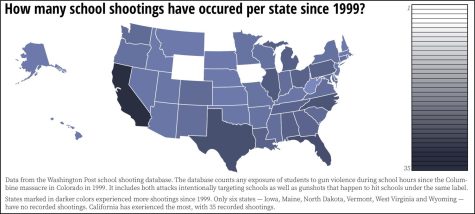Column: Schools must act to prevent shootings
December 11, 2021
A few weeks ago, I got a call from my brother. He told me there was a shooter threat at his school and that a bunch of students ran out of the building since the school’s administration had yet to begin a lockdown.
I was immediately petrified. A million questions ran through my head. What if the shooter is outside the building? What if the shooter is inside the building with all those other students and staff? Where is the shooter? Why isn’t anyone doing anything about it?
The high school I attended and my brother currently attends is Pelham Memorial High School, or PMHS. A student at PMHS posted a concerning Snapchat. At around the same time, another student posted a photo on social media of him holding a gun. A few days after these posts, PMHS students found out the alleged time that the shooting was going to happen.
Despite the undeniably alarming social media posts, PMHS administrators claim that the school was not in any clear danger and that the “planned shooting” was not true. The vague nature of the school’s explanation and immediate dismissal left not only my family, but also many other families, very worried.
While it’s unclear if a shooting was supposed to happen at PMHS on a particular date and time, it doesn’t change the fact that the posts understandably shook the town of Pelham to its core. It made me cry out of worry and fear. A child posting a photo with a gun and another posting a Snapchat which read “Time to f*** up Pelham?” are real, credible threats — not something to dismiss.
It quickly became a dark day Nov. 30 as Ethan Crumbley, who is 15 years old, went from being just like any other student to a school shooter when he shot and killed four fellow classmates at Oxford High School.
Upon hearing about the tragic event, I didn’t want to know any more details. When anyone around me brought it up, I asked them to stop talking about it. I didn’t want to hear about a child murdering their classmates — it just hit too close to home. However, little by little, I heard pieces of the story. The more I heard the more similar it sounded to what happened at the high school I graduated from and that my brother currently attends.
Crumbley, similarly to the PMHS students, showed clear indicators of being fascinated with weapons. A teacher found an image he drew of someone getting shot and bleeding out while screaming for help. Crumbley was then called to the guidance counselor’s office, where he claimed it was for a video game. School officials told his parents to take him home for the day, but they refused. Not only did he draw this grotesque image, he posted a photo of himself on Instagram with a semi-automatic gun, detailing how he was going to shoot up the school.
Pelham was lucky. Oxford was not. But there is a similarity between the two stories: Both schools handled the situation poorly. Pelham was dismissive of the threat, and so was Oxford. The “rumor” about the date and time of the shooting that spread around the halls of PMHS, ultimately making many students flee the school in desperate need of safety, might have saved lives while the administration sat by and did next to nothing.
Studying these two events, it’s clear that many schools aren’t ready to face the unthinkable. No matter how maddening it is, school shootings are all too commonplace in the United States. We need to plan accordingly for the worst outcome and understand the importance of taking threats seriously. If we all did this, plans would be more polished and neglectfulness wouldn’t cost innocent lives.
As part of a school community at Northeastern, we must do just that and make a plan. In 2019, NU students were alerted about a shooting that occured in Ruggles station an hour and a half after it transpired. Ruggles is a common place students go, which makes the late email with this troubling information unacceptable. If every school and local police departments were more transparent, then we would all be safer.
We never think it could be us. We never think that we will be the next victims of a school shooting. We never think that the next day of classes could be our last. This is part of the issue. Schools must take every threat seriously. Children like Crumbley need mental health resources which many schools lack, including Northeastern. This issue boils down to who cares enough to stand up for transparency and increase mental health funds to ultimately protect our communities.
Madison Boudreau Popovic is a second-year political science and business administration combined major with a minor in French. She can be reached at [email protected].


















